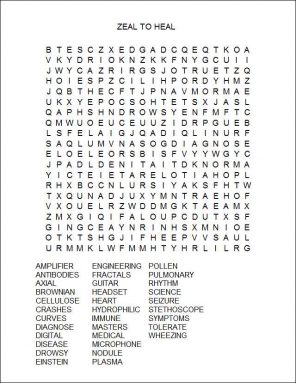Teens exhibit a zeal to heal
Science and engineering foster creative approaches to tackling serious biomedical issues
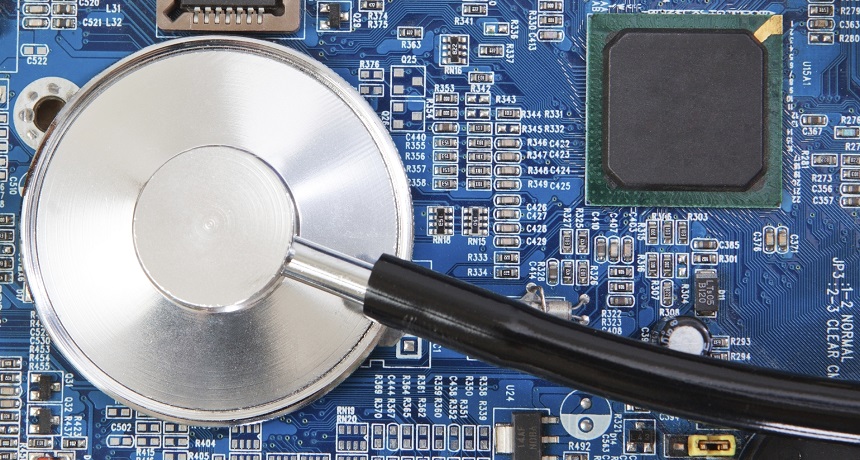
From souped-up stethoscopes to math and computer technology, a group of young teens is working hard to make medicine more effective.
sergoua/istockphoto
By Sid Perkins
Annika Urban had a problem.
A few years ago, the now-13-year-old started having difficulty breathing when she exercised. “I’d wheeze a lot and get a very nasty cough,” recalls this student, who attends Dorseyville Middle School in Pittsburgh, Pa.
Annika wanted to know the cause of her problem. Diagnosing it was neither quick nor easy. “Often the symptoms went away before I could get to the doctor,” she explains.
Her solution involved a new hack of an old medical instrument. It won the admiration of her doctor. It also won the attention of the judges at the 2014 Broadcom MASTERS competition.
Here, MASTERS stands for Math, Applied Science, Technology and Engineering for Rising Stars. It also is the premier middle school science and engineering research competition. The prestigious event was created by the Society for Science & the Public, which also publishes Science News for Students. The Samueli Foundation, a non-profit organization created by Broadcom founder Henry Samueli, sponsors this competition.
Annika was among the 30 finalists who presented their research, last October, in Washington, D.C. The judges were so impressed with Annika’s invention they awarded her second place in engineering.
Like Annika’s invention, many of the finalists took on projects in biomedicine. It’s the field that explores the biological basis of injuries or disease and their treatments. For example, 12-year-old Raghav Ganesh invented a device that clips onto a cane. It can detect possible trip hazards in a blind person’s path. For that effort, the middle-schooler from San Jose, Calif., earned one of the competition’s Rising Star awards.
Several other finalists used mathematics to help doctors better diagnose diseases. Yet another sought to develop a new material for biomedical implants so that they won’t cause inflammation or infection. Here, we highlight some of the nifty projects that won a handful of young researchers a place in the Broadcom finals.
Now hear this
Annika’s invention is based on the traditional stethoscope that doctors often wear around their necks. A small, disk-shaped chamber placed against the body carries sound through a Y-shaped rubber tube to twin earpieces. The stethoscope allows doctors to listen to the heart and lungs. Annika’s idea was to adapt it to record the sounds of her own breathing. Then she could play them back for her doctor — even long after her wheezing and coughing had subsided.
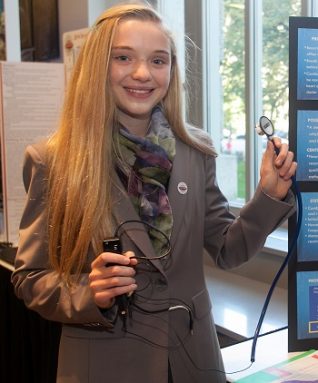
For the second version of her device, Annika added a $50 bit of electronics. Called a pre-amplifier, it uses the same sort of circuitry as electric guitars. This pre-amp boosts the volume of any low-frequency sounds. After that change she found that “the recorded heartbeats and breath sounds were very distinct.”
Annika named her gadget the “stethophone.” (Like the invention itself, it’s a mash-up of “stethoscope” and “microphone.”) The quality of its recordings impressed Annika’s doctor, who suggested it could be useful in a variety of situations. Those include monitoring patients at sea, on a battlefield or any place without a doctor nearby.
Math rules!
Another project also analyzed symptoms to help doctors diagnose disease. In this case, the symptoms can emerge and develop very slowly. But recognizing them early could be a key to saving someone’s life.
Muhammad Abdulla, 15, lives in Melbourne, Fla. This 8th-grader used high-powered mathematics to study electrocardiograms. These are recordings of the electrical activity in a beating heart. (Electrocardiograms are often called EKGs for short.) Doctors can use EKGs to identify many different heart problems.
Muhammad wondered if he could analyze EKGs in different ways to pinpoint the signs of disease years earlier than is now possible. To do this, he used two techniques to look at actual EKGs. He got those EKGs from a website where patients had posted them and their diagnoses anonymously.
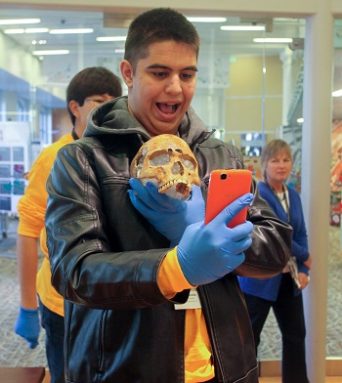
Muhammad’s fractal technique analyzes an EKG and then calculates a score, the teen explains. The scores for EKGs from healthy hearts fall within a certain range. The further a number lays outside of that normal range, the more severe a patient’s case of heart disease, he found. His Brownian motion technique is slightly different. It analyzes the EKG and then estimates the chance that the patient is healthy.
Muhammad combined both techniques to compare EKGs from healthy and sick people. Both techniques proved useful. However, the Brownian motion one appears better at spotting long-term changes in heart health, he found. In fact, by analyzing several EKGs posted by the same patient, Muhammad found that signs of unusual electrical activity were present four years before a doctor first realized that the patient had heart disease.
One day, Muhammad says, doctors using these simple mathematical techniques might be able to recognize signs of heart disease far earlier than they normally do today.
Scan scanner
Aditya Jain, 14, of Portland, Ore., also harnessed math for his Broadcom project. He analyzed digital images of lungs called CT scans. (CT is short for computerized axial tomography. That’s a type of X-ray scanning technique to digitally create a view of a slice of tissue inside a body.) Aditya wanted to come up with a way for a computer to automatically scan CT images of the lung, looking for signs of cancer.
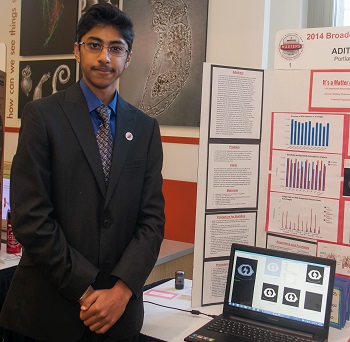
To test his new computer program, Aditya had it analyze 10 lung scans with known signs of cancer. And the results were encouraging. Overall, the computer correctly identified the nodules 88 percent of the time. At the Broadcom MASTERS, Aditya took home the first place prize in technology for this research.
Aditya now would like to improve the accuracy of his computer software. He’d also like it to know the difference between cancerous and non-cancerous lung nodules. The teen suspects his software not only could find signs of cancer early, but also cut the overall number of scans a patient might have to get. That would reduce their exposure to X-ray, he explains. That’s important: Such radiation can itself trigger the development of cancer.
Don’t sleep and drive
Katherine Wu is 14 and lives in North Potomac, Md. Her family often vacations in Florida. One year, she remembers her parents driving late into the night. From the back seat, she could hear her mom talking to her dad to make sure he stayed awake.
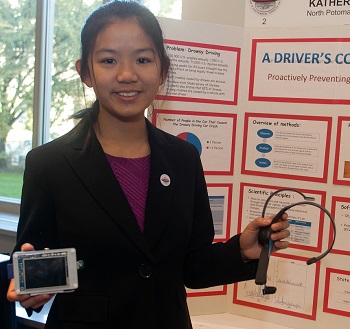
When drivers travel solo, they are on their own. They might play the radio loudly or roll down the car’s windows to try and stay alert. Neither really helps keep a driver awake, Katherine says. So she decided to design a device that could alert drivers as soon as signs of drowsiness emerge.
The teen had heard about headbands filled with sensors that monitor electrical activity in the brain. These are the same sorts of sensors used to measure electrical activity in the heart to produce EKGs. When used to measure brain activity, these sensors’ results are called EEGs, for electroencephalographs (ee-LEK-tro-en-SEFF-uh-lo-GRAFS).
An EEG will vary quite a bit when someone is awake, asleep — or even just drowsy, Katherine explains. What’s more, sleepy people blink much more often than those who are awake and alert. So Katherine developed a headset to measure brain waves and to count eye blinks. That headset sends its data wirelessly to a simple computer. The computer beeps or plays music when it detects signs of drowsiness. Those sounds should warn a driver to pull over and take a break — or even a quick nap.
Such devices could do a world of good in reducing deaths and injuries associated with accidents involving sleepy drivers, the teen suspects.
Rejection is no fun
The human body’s immune system is very good at defending itself against anything foreign. This includes viruses and bacteria that can cause harm. Unfortunately, it also includes things placed inside the body to help a patient. Such implants can include devices that dispense drugs or stimulate electrical activity to regulate the rhythm of heart beats.
Arnob Das, 15, of Portland, Ore., understands how medical implants can have bad side effects. A 6-year-old girl he knows had a bad reaction to a device implanted to control her seizures. About a month after the device was inserted under her skin, doctors had to remove it. The implant had triggered severe inflammation. Inflammation is how the body responds to cellular injury. It often creates swelling, redness, heat and pain. “If the inflammation had occurred somewhere else in the body, if might have been deadly,” Arnob says.
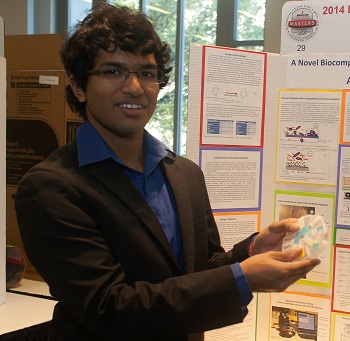
Arnob worked on designing materials that would prove super-attractive to water. First, he zapped oxygen molecules with high-powered radio waves. That created a hot, gas-like state of matter called plasma. Then he bombarded five different materials with this plasma. Those materials included plastics and other polymers, which often are used to make implants. Arnob also included cellulose. It’s a natural polymer made by plants.
Arnob showed that giving cellulose the plasma treatment makes it more water-loving than the other materials he tested. Because cellulose is a natural material, coating implants with it should not be very costly, he suspects.
If this research leads to implants that the body can tolerate better, patients could enjoy an improved quality of life. “And the one important thing to me is to make the world a better place for everyone,” says Arnob.
That’s not just his goal; it’s goal of every expert in biomedicine — including the Broadcom finalists whose work was profiled here.
Power Words
(for more about Power Words, click here)
amplifier A device that boosts the power of a signal. For example, amplifiers are often attached to electric guitars to make them louder.
antibody Any of a large number of proteins that the body produces as part of its immune response. Antibodies neutralize, tag or destroy viruses, bacteria and other foreign substances in the blood.
bacterium (plural bacteria) A single-celled organism forming one of the three domains of life. These dwell nearly everywhere on Earth, from the bottom of the sea to inside animals.
biomedicine The field of research that explores the biological basis of injuries or disease and their treatments.
Brownian motion The random, back-and-forth jittery motion of tiny particles in a fluid. The phenomenon is named after the Scottish botanist Robert Brown, who discovered such motions when he was looking at pollen grains in a fluid under a microscope in 1827. (Those movements had been caused by molecules of water, too small to be seen themselves, constantly slamming into the particles from all directions.)
cellulose A type of fiber found in plant cell walls. It is formed by chains of glucose molecules.
chronic A condition, such as an illness (or its symptoms, including pain), that lasts for a long time.
computerized axial tomography (CAT or CT, for short). A special kind of x-ray scanning technology that produces cross-sectional views of the inside of a bone or body.
computer program A set of instructions that a computer uses to perform some analysis or computation. The writing of these instructions is known as computer programming.
diagnose To analyze clues or symptoms in the search for their cause. The conclusion usually results in a diagnosis — identification of the causal problem or disease.
digital (in computer science and engineering) An adjective indicating that something has been developed numerically on a computer or on some other electronic device, based on a binary system (where all numbers are displayed using a series of only zeros and ones).
electrocardiogram A test (or the readout of that test) that records electrical signals moving through your heart. This assay is usually abbreviated as an ECG or EKG test. Special cells in the upper right chamber of the heart emits these signals, which trigger the heart to beat.
electroencephalogram or electroencephalography (abbreviated as EEG) A record of electrical activity in the brain. Electrodes attached to the surface of the head chart a series of waves.
filter (in chemistry and environmental science) A device which allows some materials to pass through but not others, based on their size or some other feature. (in physics)A screen, plate or layer of a substance that absorbs light or other radiation or selectively prevents the transmission of some of its components.
fractals Complex mathematical curves that have the same shape at all levels of size, from the microscopic to the gigantic. Fractals are particularly useful for describing jagged lines or rough surfaces.
frequency The number of times a specified periodic phenomenon occurs within a specified time interval.
immune system The collection of cells and their responses that help the body fight off infection.
inflammation The body’s response to cellular injury; often involves swelling, redness, heat and pain.
molecule An electrically neutral group of atoms that represents the smallest possible amount of a chemical compound. Molecules can be made of single types of atoms or of different types. For example, the oxygen in the air is made of two oxygen atoms (O2), but water is made of two hydrogen atoms and one oxygen atom (H2O).
nodule A small roundish bump or growth.
plasma (in chemistry and physics) A gaseous state of matter in which electrons separate from the atom. Plasma includes both positively and negatively charged particles.
polymer Substances whose molecules are made of long chains of repeating groups of atoms. Manufactured polymers include nylon, polyvinyl chloride (better known as PVC) and many types of plastics. Natural polymers include rubber, silk and cellulose (found in plants and used to make paper, for example).
pulmonary Adjective for things that relate to the lungs.
radiation Energy, emitted by a source, that travels through space in waves or as moving subatomic particles. Examples include visible light, infrared energy and microwaves.
seizure A sudden surge of electrical activity within the brain. Seizures are often a symptom of epilepsy and may cause dramatic spasming of muscles.
software The mathematical instructions that direct a computer’s hardware, including its processor, to perform certain operations.
statistics The practice or science of collecting and analyzing numerical data in large quantities and interpreting their meaning. Much of this work involves reducing errors that might be attributable to random variation. A professional who works in this field is called a statistician.
tablets (in computing) A small, hand-held computer that can connect to the Internet and that users can control using a touch screen. The Apple iPad, Samsung Galaxy and Amazon Kindle Fire are all examples of tablets.
tissue Any of the distinct types of material, comprised of cells, which make up animals, plants or fungi. Cells within a tissue work as a unit to perform a particular function in living organisms. Different organs of the human body, for instance, often are made from many different types of tissues. And brain tissue will be very different from bone or heart tissue.
virus Tiny infectious agents consisting of RNA or DNA surrounded by protein. Viruses can reproduce only by injecting their genetic material into the cells of living creatures. Although scientists frequently refer to viruses as live or dead, in fact no virus is truly alive. It doesn’t eat like animals do, or make its own food the way plants do. It must hijack the cellular machinery of a living cell in order to survive.
Word Find (click here to enlarge for printing)
